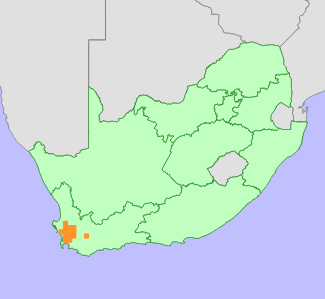|
Scientific Name | Aspalathus aculeata Thunb. |
Higher Classification | Dicotyledons |
Family | FABACEAE |
Synonyms | Achyronia aculeata (Thunb.) Kuntze |
National Status |
Status and Criteria | Vulnerable B1ab(i,ii,iii) |
Assessment Date | 2015/01/14 |
Assessor(s) | D. van der Colff, I. Ebrahim, D. Raimondo & H. Stummer |
Justification | EOO estimated between 4744-5026 km², with around 36 small, severely fragmented subpopulations remaining. Around 80-88% of this species' habitat has been lost to agricultural expansion (cultivation of wheat, olives and vineyards) and urban expansion. It continues to decline due to the impacts of population fragmentation, infrequent fire, invasive alien plant infestation and habitat degradation. |
Distribution |
Endemism | South African endemic |
Provincial distribution | Western Cape |
Range | Piketberg, and Durbanville to Paarl. |
Habitat and Ecology |
Major system | Terrestrial |
Major habitats | Swartland Shale Renosterveld, Breede Shale Renosterveld, Montagu Shale Renosterveld, Swartland Granite Renosterveld, Swartland Alluvium Renosterveld, Boland Granite Fynbos, Northern Inland Shale Band Vegetation, Swartland Alluvium Fynbos, Breede Alluvium Fynbos |
Description | Variable, occurring inn a variety of soil types within lowland renosterveld and fynbos. |
Threats |
| This species prefers nutrient-rich soils (Dahlgren 1988) and has lost more than 80% of its habitat to crop cultivation in the past 70 years, a period exceeding three generations. It has also declined due to habitat loss to urban expansion around Stellenbosch in the past, and is currently threatened by habitat loss to urban expansion around Darling and Wellington. This species is dependent on fire for regeneration, and the main ongoing threat is a lack of fire in small remnants of natural vegetation. Competition from unmanaged alien invasive plants is also an ongoing threat to many remaining subpopulations. |
Population |
This species has a limited distribution range, but is still fairly common within this area, in spite of extensive habitat loss. Recent records indicate that it occurs in at least 36 lowland fynbos fragments. Most subpopulations are small, consisting of less than 1000 mature individuals. However, these subpopulations are in areas that have not burnt in a long time. This species is known to respond to fire with rapid mass-regeneration, and can be locally dominant in the first few years following fire, but then dying off, becoming dormant in the seed bank. It is somewhat weedy and resilient to disturbance, and often survives in very degraded fragments.
|
Population trend | Decreasing |
Assessment History |
Taxon assessed |
Status and Criteria |
Citation/Red List version | | Aspalathus aculeata Thunb. | VU B1ab(i,ii,iii) | 2015.1 | | Aspalathus aculeata Thunb. | EN B1ab(iii,v) | Raimondo et al. (2009) | |
Bibliography |
Dahlgren, R. 1988. Crotalarieae (Aspalathus). In: O.A. Leistner (ed). Flora of southern Africa 16 Fabaceae, Part 3 Papilionoideae, Fascicle 6:1-430. National Botanical Institute, Pretoria.
Goldblatt, P. and Manning, J.C. 2000. Cape Plants: A conspectus of the Cape Flora of South Africa. Strelitzia 9. National Botanical Institute, Cape Town.
Raimondo, D., von Staden, L., Foden, W., Victor, J.E., Helme, N.A., Turner, R.C., Kamundi, D.A. and Manyama, P.A. 2009. Red List of South African Plants. Strelitzia 25. South African National Biodiversity Institute, Pretoria.
|
Citation |
| van der Colff, D., Ebrahim, I., Raimondo, D. & Stummer, H. 2015. Aspalathus aculeata Thunb. National Assessment: Red List of South African Plants version 2024.1. Accessed on 2025/10/26 |
 Comment on this assessment
Comment on this assessment


